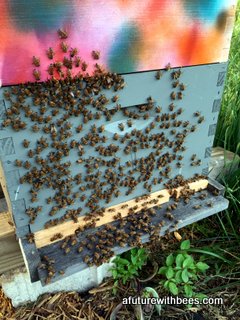August in this area is a hot dry month with little activity for the bees. The nectar flow has pretty much stopped and the hives are not gaining any significant weight. The bees have stopped drawing foundation because the nectar flow has stopped.The queen starts slowing down her egg laying rate and the population starts to decline. Mostly, they are in maintenance mode for the next few months. They keep the hive cool by fanning, finish capping the honey, and work to corral the SHB (small hive beetles).
The beekeeper can slow down as well. Swarming is long past and the hives only need to be checked once a month or so if they are set up well. I will be feeding those hives that are too small to winter well. Also feed those hives that still need to draw enough comb to winter. August is a good time to swap out equipment – replace any equipment on the hives with new or refurbished equipment. Re-move and repair those boxes, lids, and bottom boards that are cracked, damaged, or need repainting or repaired.
I will also be harvesting the honey and preparing for any possible late nectar flows. After harvesting the honey, I will return one wet box back to the hive in case they find something to work and need to store more honey. This honey is often darker and has a rich, fuller flavor than early honey.
My boxes and combs are stored dry and in the open air. I have very few problems with wax moths. I will discuss storing equipment in the next month’s articles.
Lessons I’ve learned:
- The bees ventilate hives very well on their own. If I add a couple of “ventilation holes”, it slows them down because I mess up their air flow within the hive. They don’t want, or need, ventilation. My best hives are those that are left alone!
- Feed weak hives NOW! There is not enough nectar for weak hives to get to winter strength and they need to get strong now. Trying to boost them to strength in the late fall is too little, too late. If these weak hives cannot make the grade in the next 2 months, it is an indication that they are not good performers and need to be culled. I will discuss “taking your winter losses in the Fall” in future articles.
- SHB populations peak in August. But, even though I am seeing more of them, this does not mean there is a problem. The bees handle them very well. The mistake I make is opening up the hives too often in Late July and August. This breaks the propolis prisons the bees use to control the beetles. If I don’t “jail break” the beetles, the bees have them under control.
- Small hive beetles are opportunistic predators who prey on weak hives that don’t have enough bees to defend themselves. SHB will not cause a strong hive to crash. If there is a problem with SHB, the hive had a problem weeks or months earlier that I did not catch. Strange to say, but SHB can make us better beekeepers by teaching us to pay better attention and catch problems early.
- Honey harvesting can cause robbing to start. Robbing doesn’t normally start until August because the bees have enough to do until then. But August is a slow month with almost nothing for them to harvest. So instead of being occupied, they are searching for something to do. Along comes the beekeeper who starts stacking honey supers in the truck. Honey supers that are undefended. They figure this out REAL QUICK! A robbing frenzy can occur. Then the beekeeper drives away and the robbers, who are still looking for that easy bounty, turn to the weaker hives in the yard and start robbing them. Funny, but they don’t normally rob the weaker hives unless we give them the idea….
- So, when harvesting honey supers, keep them tightly lidded on the top and bottom. Don’t let that robbing mode start! I’ve gone back to yards a week after making this mistake and the bees “greet” my truck as soon as I pull in! Free honey is not easily forgotten!
- Most hives will not draw foundation after July, even if you feed them heavily. It is easy to get caught up in the thinking “I have 2 more months of hot weather to get comb drawn for the winter”. But hot weather is not the key – Nectar flow is. And we cannot fool most hives into believing the nectar flow is still on. I have been caught short, with not enough drawn combs to winter the hive. If you don’t have enough drawn comb, try feeding those hives heavily. If they can’t be fooled, you may have to plan on getting some combs someplace else.
I hope that sharing the lessons I’ve learned, will help you avoid making the same mistakes.
